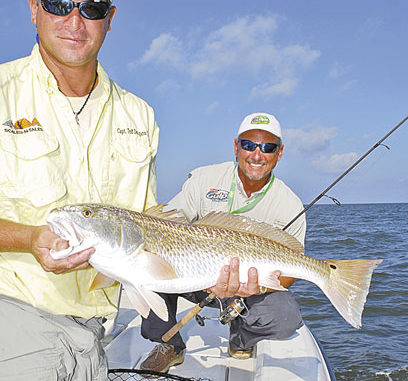
How old is that redfish? Fishermen are, for the most part, intensely curious about their quarry. One of the most common questions they have, besides about what fish eat, is speculation about the age of the fish they catch, especially big fish.
But guessing age from size can be tricky, especially in larger fish. Some variability is genetic. In humans, for example, a center on a professional basketball team is always a lot bigger than would be a race horse jockey of the same age.
Some the variability in size in fishes is due to gender. In most, but not all, fishes females will average being larger than males of the same age. This would seem illogical at first glance because producing large eggs would seem to divert more nutrients away from growth than would producing tiny sperm.
Various theories have been proposed to explain gender size differences, but no one theory fits all species.
Gender and size are complicated by the strange fact that some fish species switch sex in mid-life. In protogynous (meaning “first female”) species like groupers, all fish start out their spawning life as females and only later become males. Other gender-bending fish, called protandrous species, start life as males and later become females. Protandry is the less common of the two, and occurs most often in harem-forming reef species.
Finally, there is the vague but critical factor of habitat influences. While hard to quantify, there is no doubt that some habitats are superior for fish growth than others.
But, back to redfish. Age is easy to guesstimate for a small redfish. Those pesky, undersized, 10- to 15-inchers of the summer are all the result of last year’s August to October spawn. But after that size, guessing age gets harder.
A few 2-year-old fish will be mature enough to spawn. They will average 27 inches long and 9 pounds in weight. But the average 27-incher, either male or female, will be age-4. And the slow developers, especially in females, will not reach that size until age-6.
Redfish can live more than 40 years, although few make it past their mid-30s. They grow their entire lives, but growth rate will vary significantly from fish to fish. The largest individual fish are often not the oldest fish.
In a study done at LSU in 1983, a 21-year old fish weighed in at 34 pounds and was 42 inches long, while another of the same age was only 31 inches long and weighed 15 pounds.
A major variable in redfish growth rate is gender. Females grow faster than males once the fish mature and move to offshore waters. The size gap between the sexes remains fairly small until about 9 years old. At that age, females average 33 inches and over 16 pounds. Males average 32 inches and 15 pounds.
But by age 15, females average 36 inches and 22 pounds and males 34 inches and under 19 pounds. After that age, both sexes seem to experience a slower growth rate, but males slow down even more than females. At 30 years old, females average 39 inches and 29 pounds. Males average under 36 inches and weigh only 22 pounds.
Some evidence was found by LSU scientists in 2000 that growth rates of redfish during the first six years of their lives became slower after protective harvest regulations were put in place in the late 1980s. This may be due to more competition between the increased numbers of fish for food and space in Louisiana’s inshore waters.
Redfish, regardless of where they are caught, tend to be home-grown. Twenty-five years of tagging research in Texas revealed that 87 percent of the tagged redfish that were recaptured were caught in the same bay system from which they were originally caught and tagged.
Some redfish do travel however. One, tagged in Matagarda Bay, Texas, was caught 376 miles away, near East Timbalier Island. Another redfish, released in Galveston Bay, traveled 283 miles before being recaptured near Grand Isle.
Jerald Horst is author of four books on fish and seafood including the acclaimed Trout Masters: How Louisiana’s Best Anglers Catch the Lunkers.


